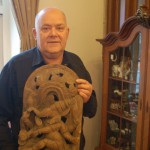
Sjöbo is an ideal spot for reaching most parts of Skåne including Österlen to the east. Within less than 30 minutes by car, you can be in Lund, Malmö, Ystad or Simrishamn. But getting around Skåne was not always this easy. Visitors of old often required a supply of fresh horses at strategically placed inns. That’s how Sjöbo Gästgifvaregård first started. Ever since 1700, there has been an inn at this location in the heart of Sweden’s southernmost county – Skåne. But there is something distinctly ‘unSwedish’ about Sjöbo Gästgifvaregård. The architecture is like a French chateau and inside are 3,500 elephants from around the world.
Ingeborg Liedholm, who ran Sjöbo Gästgifvaregård from 1917 to 1955 with her husband Hilding, loved elephants. Her guests used to bring her elephant souvenirs and ornaments when they returned from their travels in exotic lands. She dutifully registered each gift in a book and gave each elephant a name. By the time she died, her collection had grown to 500 elephants which are now displayed in a cabinet in the lobby of Sjöbo Gästgifvaregård.
The current owners Lennart and Eva Mårtensson have continued the tradition so visitors continue to bring elephants as gifts. The whole hotel is now overrun with elephants featured in every display cabinet and window sill. There are flying elephants decorating the dining area. An elephant is also part of the logo of Sjöbo Gästifvaregård.
This is just part of the quirky history of an inn that has been welcoming travellers since around 1700. This type of inn is known in Swedish as a gästgivaregård or gästis, which means more than simply a guesthouse. The name designated a statutory inn that was primarily for the nobility and ruling classes. No one else, apart from their entourage, was allowed to stay there.
During the first half of the 17th century, when representatives of the Swedish crown and Swedish noblemen travelled the length and breadth of the country, local farmers were obliged to offer them free accommodation. In 1649, this obligation was removed but farmers were still obliged to provide fresh horses free of charge to move these travellers from A to B. As a result, a series of coaching inns with stables were set up around the country. The law stated that these inns should be about 20 km apart to allow a change of horses at regular intervals along key routes. The routes were often signposted with milestones giving distances to the next inn.
So it was that Sjöbo Gästgifvaregård first came into existence around 1700 located at the crossroads of the Ystad to Hörby road and the Malmö to Simrishamn road. It was strategically located between Hörby and Herrestad. Incidentally, the inn in Herrestad dating from this period is still in existence today and open for guests as is the inn in Hammenhög on the old road east to Simrishamn.
In the old days, the innkeepers did not earn anything for providing horses. To compensate, they were exempted from paying tax and were given a monopoly to sell alcoholic beverages in a 20 km radius. Thus the inns became a focal point for the community and this is still true today.
Sjöbo Gästgifvaregård is today a popular venue for weddings and other family gatherings and has by far the largest restaurant in Sjöbo. It is a popular place to eat, priding itself on serving traditional Swedish recipes made with local produce. This is where the local people of Sjöbo eat out. Indeed, Sjöbo Gästgifvaregård was once a favourite haunt of one of Skåne’s most famous authors, Fritiof Nilsson Piraten (1895-1972), who wrote colourful stories about this area.
“We have a lot of Danish guests who appreciate the tradition of a local inn. In Denmark, the local inn still lives on in many rural towns. Many Danes come here in search of their history because Skåne was once part of Denmark,” says Lennart Mårtensson. The origins of his inn date from a time when the Swedish crown and military were keen to establish control over a part of Sweden that had only just been conquered from the Danes in 1658 and was still the subject of dispute.
One of the early visitors was the famous Swedish botanist Carl von Linné. He and his party planted two elm trees here in 1749. He stayed at Sjöbo to do an inventory of natural resources and land in the area. The inn is mentioned in his travel book “Den Skånske resan” (“Travels in Skåne”) where he comments on the softness of the down made from goose feathers.
Nothing remains of the original inn which was a low building with a thatched roof. The current eye-catching design dates from 1901. A firm of Swedish wine merchants from Malmö called Wiens & Sederholm first rented and then bought the property as an outlet for selling alcoholic beverages. They rebuilt the inn in the grand style of a French chateau or hunting lodge with distinctive oval windows. The building looks more at home in Versailles than in the provincial town of Sjöbo.
”Many of our international guests come from Denmark, Norway and Holland. They like the character of the place and our rooms rapidly fill up in the summer months,” says Lennart, who has been running Sjöbo Gästgifvaregård with his wife Eva since 1997. He has noted an increase in interest for online booking via sites like www.booking.com and www.hotelspecials.com. The inn is also to be found on Facebook at sjobogastis.
Even if the guest rooms are sometimes full, guests are welcome to the restaurant or bar seven days a week. And if any guests want to bring an elephant with them, Lennart will always make room for it!
